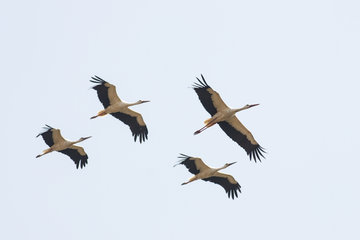Gliding without wings
Geckos' crash landing abilities may inspire new techniques for robot mobility
Geckos’ impressive climbing abilities give them agility rarely surpassed in nature. With their highly specialized adhesive lamellae on their feet, geckos can climb up smooth vertical surfaces with ease and even move on a ceiling hanging upside down. Their ability to run on water is another superpower. Now another can be added: the multi-talented lizard known as Hemidactylus platyurus is capable of gliding. In its natural habitat, it lives in trees and can jump many meters from one tree trunk to the next to avoid predators. When trees are close and the jump is short, the gecko is still accelerating so that everything between jump and landing happens in the blink of an eye. The gecko experiences an unbraked collision. Surprisingly, the gecko can cope with smashing full-on into a tree trunk.

Ardian Jusufi, who works at the interface between robotics and biology, has set up several experiments in a wildlife reserve in the rainforests of Singapore to explore how geckos can use their tails to control gliding flight, aim at a target at lightning speed and land in confined spaces. At the Max Planck Institute for Intelligent Systems, he leads the Cyber Valley research group Locomotion in Biorobotic and Somatic Systems. He has spent many years investigating geckos and discovered several of their locomotion capabilities.
Stabilising tail
Geckos shed their tails when they are in danger. This grows back after a short time. This enabled Ardian Jusufi to explore a situation where reptiles both with and without a tail face the challenge of a short accelerating glide
Placed on a platform seven meters above the ground, a tail-equipped gecko leaps down into the deep and glides to a nearby tree.
High-speed cameras capture the fall and show that the jumping gecko reaches a speed of 6 metres per second, which is just over 21 km/h. Unlike a car that would be heavily dented after driving into a tree at this speed, the footage shows the gecko landing on the trunk without falling off. It moves away as if nothing happened. With tailless animals, it was quite the opposite. Geckos who had naturally lost their tails could not maintain their grip after the crash and, consequently, fell off the tree trunk after landing.
As can be seen in the corresponding video, the mechanism the animal applies to cushion the impact is bending its torso backward as far as 100 degrees. During the bend, the front feet lose grip. Only the rear legs remain attached. This pitch-back of the torso dissipates energy as it pushes the tail hard into the trunk. Animals that have lost tails could not dissipate suffient energy and fell. The tail acts as a fifth leg, helping the gecko stabilize after the impact, they believed.
Control experiments in the lab

But without a control experiment can one conclusively show that the tail has this stabilizing effect? To tackle this questions, the researchers set off to the lab and created a physical model of a gecko to better understand the forces the animal experiences. To this end, they created a gecko-inspired robot. It features a soft torso, where the tail can be taken off and put back on. When the front “foot” hits a surface, the robot is programmed to bend its tail just like the reflex that Jusufi discovered previously in climbing geckos. The information is processed via a microcontroller on the “shoulder”. This signal activates the motor to pull on a tendon and hence pushes the tail into the wall to slow the head over heels pitchback.
Together with his postdoc Rob Siddall, Ardian Jusufi now carried out several experiments. They began by catapulting a soft robotic lizard onto a wall with an embedded force-sensitive scale (the simulated tree trunk) which is lined with felt, to which the robot’s Velcro-lined feet can stick.
The robot hit the force plate as abruptly as the geckos hitting the tree, tilting back its torso at a right angle to the surface. The roboticists then measured the force the front and back feet of the robot endured upon impact. The longer the tail, they discovered, the lower the force pulling the back feet away from the surface. The lower that force, the easier it is for the robot (and likely the animal) to hold on. Without a tail, however, the forces on the back feet become too high – the robot loses grip, bounces of, and falls.
This experiment validated the scientists’ hypothesis that the tail is essential for the gecko to be able to stabilize itself on a vertical surface after colliding with it at high speed-findings that could make a significant contribution to robot landings and beyond.
“With the robot, we were able to measure something we could not with geckos in the field. The wall reaction forces at the impact upon landing confirmed that the tail is an essential part facilitating the landing in subcritical glides. Our soft robotic lander not only helps to make an impact in another field, but it can also help improve robot locomotion by increasing robustness and simplifying control,” explains Ardian Jusufi.
"Nature has many unexpected, elegant solutions to engineering problems - and this is wonderfully illustrated by the way geckos can use their tails to turn a head-first collision into a successful perching maneuver. Landing from flight is difficult, and we hope our findings will lead to new techniques for robot mobility – sometimes crashes are helpful," Robert Siddall describes.
Additional image and video material is available on this website.













